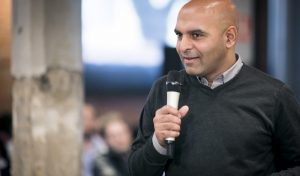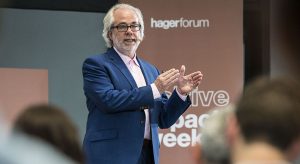The Expert View: How To Change The Culture of Financial Services Organisations?
Having previously been in the centre of other global crises, financial sector organisations today are in a different position. Following the covid-19 pandemic, industry analysts believe there is now an opportunity for the sector to support the recovery efforts and play a leading role and reshaping a more sustainable kind of capitalism.
The very real pressures of dealing with new competitors as well as the challenges of climate change, diversity and digital transformation give the industry the opportunity to lead the movement to embrace a more diverse, innovative and a stakeholder-centred vision. The change, naturally, starts with a shift of mindsets and the reshaping of the company culture.
We asked four experts from our global educator network to share their advice on how to effectively change the culture of a financial services organisation – and whether they recommend a more incremental or a disruptive approach to change. Their answers reveal that context plays a big part and, while there isn’t a one-size-fits-all solution, there certainly are very good examples of businesses that have done it successfully.
1. Start from the top

Joe DiVanna is a Cambridge-based management consultant and author. As well as working regularly with Headspring clients on custom programmes, he runs his own innovation think-tank providing research and advisory services to the financial services industry. According to him, change must start from the top, and the speed and depth of cultural change are relative to the time and energy committed to the process by senior management.
“We often do not realise that people throughout the organisation look up to and emulate behaviours [of senior leaders]”, he said. “Thus, if change is to be taken seriously within the organisation the first to change must always be the senior team. Executives that ‘walk the walk’ have the greatest impact on the depth and rate of change in the organisation.”
Asked whether change should be fast or progressive, he argues that incremental change via small steps is frequently “overlooked as a means to alter the culture of the organisation”. Incidental changes, he says, “can have a big impact on the organisation’s ability to absorb the change and adopt a new behaviour”.
A key skill that executives need to develop to support the process of organisational change is what DiVanna calls cultural intelligence.
“Senior executives must develop cultural intelligence as a mechanism to accelerate change within the organisation. Developing multiple perspectives enables an executive to alter the implementation of a new strategic direction in two distinct ways: the rate of change and finely tuned adjustments to the strategic direction as economic conditions change.”
DiVanna concludes by saying that no organisation can survive by maintaining the status quo and that managing change is “the most powerful tool in the executive toolbox”.
2. Understand your context

Balvinder Powar is an associate professor of entrepreneurship and innovation at IE Business School and also managing director and COO of a space transportation organisation. According to him, context is everything. Depending on the size, structure and organisational complexity of a company, both incremental or disruptive change can work.
“People resist change unless they clearly see how they will benefit from it”, he said. “A large legacy company can be slow in transforming so they may have to adopt a longer-term view of change. But not one size fits all, so the organisation could for example try to implement change across one department first, learn best practices and then scale up the process.”
He also highlighted the importance of leadership and of bringing an outside-in perspective into the process of culture transformation:
“Strong leadership combined with clear messages and actions will also facilitate cultural transformation”, Powar added. “Organisations should be encouraged to work with third-party contributors such as start-ups to support open innovation processes and help tackle current challenges.”
3. Role model the right behaviours

Author and educator Adam Kingl believes that the assumption that culture cannot be architected is “nonsense”. According to him, the simplest and truest definition of culture is “shared behaviours”:
“If a leadership community wishes their company to display certain behaviours as an expected norm, they only have to agree what those behaviors are and then role model them consistently. When employees join a company, they almost invariably, consciously or unconsciously, look around for those who are successful in that environment and copy the behaviors that they observe. So if everyone in a leadership team role models just a few, specific behaviours, then they are communicating beyond question what it takes to succeed.”
Working with clients in many different national and organisational cultural contexts, Kingl says he repeatedly hears managers complaining about how culture gets in the way. He argues, however, that if the behaviours represent good role modeling for the organisation, then others will adopt those behaviours – not because of the leader’s charisma, but because he or she demonstrates what is really required.
“[Leadership] groups are collectively intelligent about discerning the right answer, assessing the environment or knowing, deep down, how to do the right thing. They’re not always brilliant at inventing those concepts and socialising them. Therefore, role modeling can quickly create powerful momentum for change up, down and across an organization”, he added.
Kingl warns that this approach may initially seem difficult and inauthentic. “However, with practice, a new behaviour or quality can become an inherent component of one’s character. So, being comfortable with role modeling, no matter one’s level in a company, and being fearless about imitating someone one admires are tremendous qualities.”
This concept of “imitating” in order ultimately “to become” is not new. Kingl turns to classic philosophy to explain how this approach can work:
“Aristotle believed that people cannot simply know intuitively or theoretically how to be virtuous; they cannot just study what virtue is. They must practice virtuous actions. One begins by imitating another who exemplifies virtuous characteristics, for example, copying the behaviours of a brave person in order to learn bravery, and turning those observed behaviours into habits by performing them every day. In other words, as you practice the virtue you want – even if you’re merely imitating another – you will eventually discover that you’re not just doing that virtue, but have integrated it into your being – it’s part of you.”
Kingl concludes by advising that, as English author Neil Gaiman wrote, when faced with a difficult task, “pretend to be someone who could do it. Not pretend to do it, but pretend to be someone who could.”
“I remember these words when facilitating what seems initially like impossible culture change in companies”, says Kingl.
4. Create psychological safety

Roger Steare is a philosopher, author and expert in the development and delivery of transformational leadership and corporate culture and ethics programmes for global organisations. Hailed as a “Weirdy Beardy” by the Wall Street Journal, he has worked with several UK banks looking to overhaul their company culture. He looks at the question of driving change from the perspective of individual emotions:
“Our emotions remain the most powerful drivers of human behaviour. We are at our best when we love, trust and respect each other; and when we share scarce resources fairly.”
He says that the psychological safety we feel in a group that displays these moral values is not only critical for our well-being, but also key for our ability to explore, to be curious and to learn.
“In The Fearless Organization, Amy Edmondson clearly demonstrated that psychological safety is the most important factor for learning, innovation and growth. Google has also discovered in Project Aristotle, that psychological safety is the single most important quality experienced by their most successful teams. In Firms of Endearment, a case study of 72 of the world’s most successful companies, the values of love, passion and purpose were consistent across other iconic firms such as Honda, IKEA and Unilever.”
Steare also talks about how a culture of fear can have a negative impact on organisations:
“Fear is also an emotion critical to our survival, particularly in a crisis. The release of adrenalin and cortisol enables our primal ability to fight, flee or freeze. However, a persistent level of fear is both physically and psychologically damaging. Sadly, fear is the most powerful driver of behaviour [in many organisations]. The language of compliance, controls and consequence management are symptoms of fear-driven cultures where survival overwhelms innovation and growth. In How the Mighty Fall, Jim Collins describes how hubris, greed and denial – all fear-driven emotions – lead to catastrophic failures in business.”
Steare concludes by highlighting that a safe learning culture is what helps people work together to find solutions to their big dilemmas.
“We can find answers together when we create safe learning cultures that help us to stop and think, to explore, to be curious, to listen to others’ perspectives and experiences, to argue, to reflect and then make decisions based on democracy of voice and the moral values of love, wisdom and fairness.”
The Headspring View: understanding the challenges of change leadership
The role of leaders is being completely reshaped. While setting a clear business vision is essential, it is no longer enough, particularly under the challenging circumstances we face today. We believe leaders need to present a series of desirable qualities which must underpin their behaviour. These qualities can be grouped into five key areas, which we include in our leadership development programs, depending on the needs of our clients:
1. Clarity of Purpose
Leaders must know where they want to take the business. They must display the ability and confidence to chart a course over the short, medium and long term for the business. Fundamental to this vision is an understanding about how the world will look in years to come, and therefore how the business will need to adapt and transform.
2. Resilience
Getting results means continually solving problems on a regular basis under very ambiguous scenarios. This involves relentlessness in identifying and defining a problem effectively and not giving up until a satisfactory solution has been reached. But energy levels must also be managed to avoid burnout or illness. A sense of well-being is essential to ensure positive energy is sustainable.
3. Integrity
Leading a company is primarily about getting things done in the right way. No business can survive in the modern environment without a firm sense of integrity.
4. Decision Making
Corporate growth doesn’t happen thanks to high energy levels alone; a company’s trajectory is a function of key decisions that are taken. Not everyone feels comfortable making decisions, let alone knowing how to make good ones. The reasons may be a simple lack of training or there may be emotional and psychological blocks in place.
5. Empathy
A predisposition to be curious about those around you is a vital and commonly misunderstood attribute of a leader. Interest in others underpins almost every aspect of people management and team development. Leaders cannot deploy talent effectively if they are unaware of what talent exists around them. We believe that demonstrating an interest, especially if done with some empathy, has a powerful galvanising effect on a team by making members feel they matter, engendering greater commitment, and unleashing new ways to inspire.